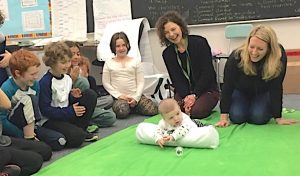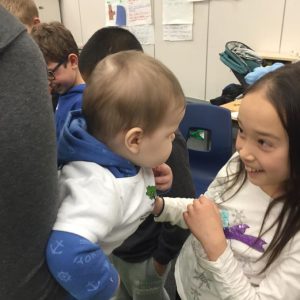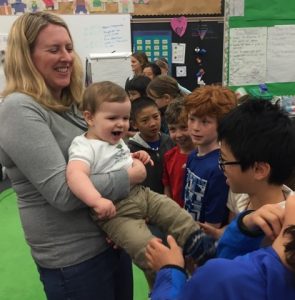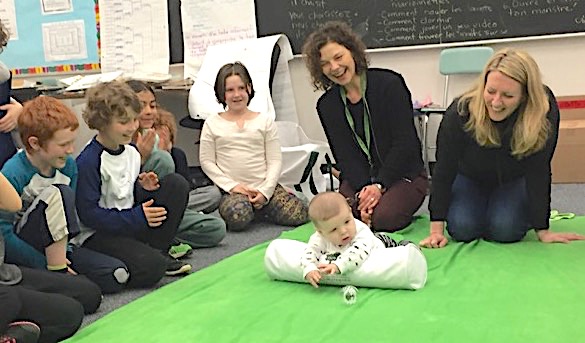By Cheryl Jackson
I arrive at my Grade Four Roots of Empathy classroom a few minutes early and wait in the hallway for the door to open. Math class is almost over and Roots of Empathy is next. Smiling faces dart over to the window in the door –the students know I’m there and they can’t wait for their lesson with Baby Thomas, his mom Maureen, and me.
Every three weeks, Baby Thomas and his mom joined me on the green blanket with 28 students and their classroom teacher. When Thomas first began his work as a Tiny Teacher, he was just four months old. He couldn’t sit or stand or walk. He couldn’t crawl. He could hardly hold his head up when laying on his tummy, a position he didn’t like at all. He loved being near his mom and she loved holding him. I remember all of this very well because we talked about it in class.
In our year together, the students learned about Baby Thomas’s temperament by watching him. He didn’t give up trying to grasp a small ball just beyond his reach. We determined that he was persistent. When he finally grabbed the ball, the students erupted with joy. When he was upset at being placed on his tummy on the green blanket, he fussed, he didn’t scream. We determined that he had low intensity, with milder reactions. We saw that when offered new things, such as a food he had never eaten, he was willing to give it a try. We determined his first reaction to new things was adventurous. Even so, Baby Thomas often looked back at his mom for reassurance. We talked about his attachment to Maureen and how her loving and  reassuring response helped him move out into the world. We learned that Baby Thomas loved music, especially when mom Maureen would move his body to the songs. We asked Maureen about that and she said she and Thomas attended a weekly neighbourhood music class because he loves music so much.
reassuring response helped him move out into the world. We learned that Baby Thomas loved music, especially when mom Maureen would move his body to the songs. We asked Maureen about that and she said she and Thomas attended a weekly neighbourhood music class because he loves music so much.
One day Baby Thomas arrived asleep in his stroller. We imagined what it would be like for him to be awakened by a loud welcome song and instead sang quietly. He woke slowly and wide-eyed, ready for his class. We tracked Thomas’s development – how he grew, what he could do now and what he could not do ‘yet’. We learned that we all develop at our own unique pace, just as Baby Thomas does.
We looked for his emotional and behavioural cues. As instructor, I guided the children to identify and reflect on Baby Thomas’s feelings and then on their own feelings and the feelings of others. They learned that babies cry because they are hungry, but also when they are lonely. They learned that babies smile when they are excited, and when they are included in activities. The children talked about how they feel when they are hungry or tired or lonely or left out.



Our close observations and reflections of Baby Thomas’s temperament traits helped us to get to know Baby Thomas – what he needed and wanted. I guided the children to reflect on their own unique temperaments. Were they high or low intensity? Persistent? Did they tend to have cautious or adventurous first reactions? What did they need or want? What, and who, helped them?
All of this happened in a 30–40 minute lesson every three weeks during a school year. Before and after each visit with Baby Thomas and Mom Maureen, I visited the class with curriculum activities to prepare and reinforce the learning. The children were given a safe place to express their feelings through stories, artwork, music and discussion. And they did.
At the end of the school year, when the classroom teacher asked the students what Roots of Empathy meant to them, one boy said ‘We are a classroom of caregivers.’
This warmed my heart.
– Excerpt from Roots of Empathy: Developing Empathy, Reducing Aggression, Barnardos UK Childlinks Journal. By Cheryl Jackson, Director, Communications and Marketing, Roots of Empathy. You can read the article here.


